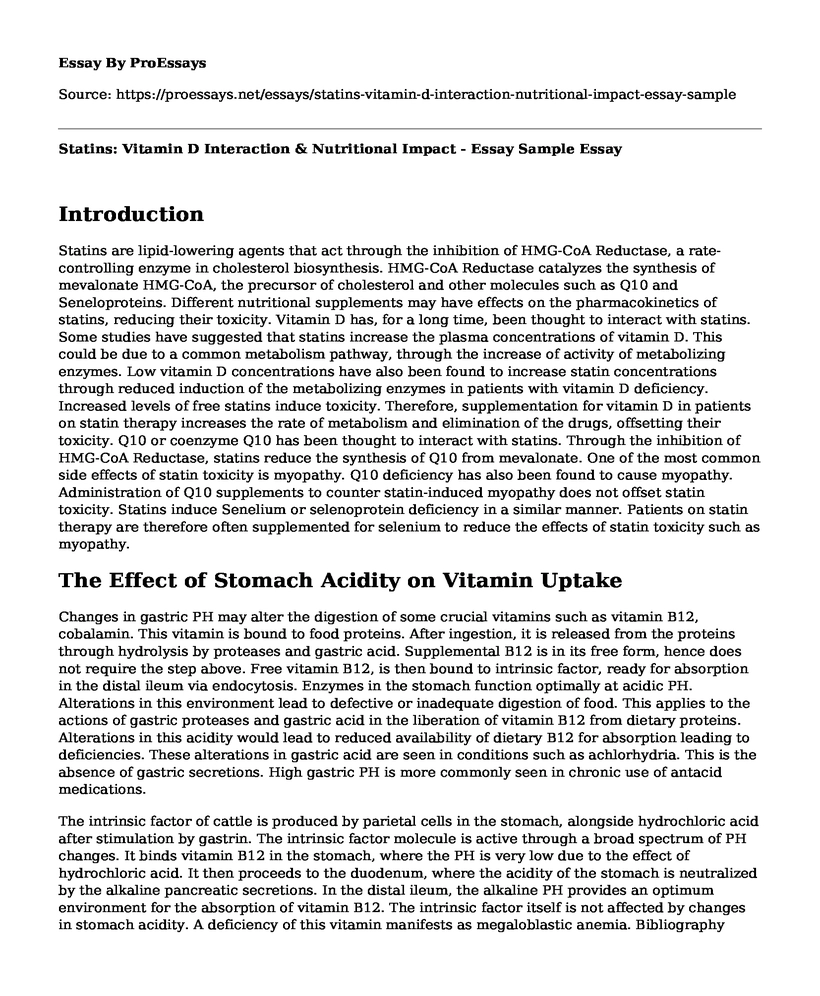Introduction
Statins are lipid-lowering agents that act through the inhibition of HMG-CoA Reductase, a rate-controlling enzyme in cholesterol biosynthesis. HMG-CoA Reductase catalyzes the synthesis of mevalonate HMG-CoA, the precursor of cholesterol and other molecules such as Q10 and Seneloproteins. Different nutritional supplements may have effects on the pharmacokinetics of statins, reducing their toxicity. Vitamin D has, for a long time, been thought to interact with statins. Some studies have suggested that statins increase the plasma concentrations of vitamin D. This could be due to a common metabolism pathway, through the increase of activity of metabolizing enzymes. Low vitamin D concentrations have also been found to increase statin concentrations through reduced induction of the metabolizing enzymes in patients with vitamin D deficiency. Increased levels of free statins induce toxicity. Therefore, supplementation for vitamin D in patients on statin therapy increases the rate of metabolism and elimination of the drugs, offsetting their toxicity. Q10 or coenzyme Q10 has been thought to interact with statins. Through the inhibition of HMG-CoA Reductase, statins reduce the synthesis of Q10 from mevalonate. One of the most common side effects of statin toxicity is myopathy. Q10 deficiency has also been found to cause myopathy. Administration of Q10 supplements to counter statin-induced myopathy does not offset statin toxicity. Statins induce Senelium or selenoprotein deficiency in a similar manner. Patients on statin therapy are therefore often supplemented for selenium to reduce the effects of statin toxicity such as myopathy.
The Effect of Stomach Acidity on Vitamin Uptake
Changes in gastric PH may alter the digestion of some crucial vitamins such as vitamin B12, cobalamin. This vitamin is bound to food proteins. After ingestion, it is released from the proteins through hydrolysis by proteases and gastric acid. Supplemental B12 is in its free form, hence does not require the step above. Free vitamin B12, is then bound to intrinsic factor, ready for absorption in the distal ileum via endocytosis. Enzymes in the stomach function optimally at acidic PH. Alterations in this environment lead to defective or inadequate digestion of food. This applies to the actions of gastric proteases and gastric acid in the liberation of vitamin B12 from dietary proteins. Alterations in this acidity would lead to reduced availability of dietary B12 for absorption leading to deficiencies. These alterations in gastric acid are seen in conditions such as achlorhydria. This is the absence of gastric secretions. High gastric PH is more commonly seen in chronic use of antacid medications.
The intrinsic factor of cattle is produced by parietal cells in the stomach, alongside hydrochloric acid after stimulation by gastrin. The intrinsic factor molecule is active through a broad spectrum of PH changes. It binds vitamin B12 in the stomach, where the PH is very low due to the effect of hydrochloric acid. It then proceeds to the duodenum, where the acidity of the stomach is neutralized by the alkaline pancreatic secretions. In the distal ileum, the alkaline PH provides an optimum environment for the absorption of vitamin B12. The intrinsic factor itself is not affected by changes in stomach acidity. A deficiency of this vitamin manifests as megaloblastic anemia. Bibliography
Works CitedFedacko, Jan, Daniel Pella Pella, Petra Fedackova, and Osmo Hannin. 2013. "Coenzyme Q10 and selenium in statin-associated myopathy treatment." Canadian Journal of physiology and pharmacology 91 (2): 165-170. https://www.nrcresearchpress.com/doi/abs/10.1139/cjpp-2012-0118#.Xrfi02gzbIU.
Mazidi, Mohsen, Peyman Rezaie , Hassan Vatanparast, and Andre Pascal. 2016. "Effect of statins on serum vitamin D concentrations: a systematic review and metaanalysis." Wiley Online Library 47 (1): 93-101. https://onlinelibrary.wiley.com/doi/full/10.1111/eci.12698.
National Institutes of Health. 2020. National institutes of health: office of dietary supplements. https://ods.od.nih.gov/factsheets/VitaminB12-HealthProfessional/#h5.
Riche, Krista, Justin Arnall, Kristin Rieser, Honey East, and Daniel Riche. 2016. "Impact of vitamin D status on statin-induced myopathy." Journal of clinical and translational endocrinology 6: 56-59. https://www.ncbi.nlm.nih.gov/pmc/articles/PMC5644425/.
Cite this page
Statins: Vitamin D Interaction & Nutritional Impact - Essay Sample. (2023, Jul 19). Retrieved from https://proessays.net/essays/statins-vitamin-d-interaction-nutritional-impact-essay-sample
If you are the original author of this essay and no longer wish to have it published on the ProEssays website, please click below to request its removal:
- Different Regulations of GMOs in Different Countries
- Anatomy and Physiology-Myocardial Infarction
- Essay Sample on Sustainability in Animal Husbandry
- Essay Sample on Lungs: Fluid Infiltration & Protein Removal Dynamics
- Nature Cries Out: Humanity Must Preserve It for Our Sake - Essay Sample
- Essay Sample on Understanding the Crucial Role of the Elbow Joint in the Upper Extremity
- Essay Example: Non-Renewable Resource Depletion & Sustainable Development Models







